Body
Vagal nerve stimulation (VNS) paired with rehabilitation is a novel treatment option for some people with long-term, moderate-to-severe arm impairment after ischemic stroke*.
When Doug had such a stroke in 2015, he was unable to use the left side of his body. He worked hard in rehabilitation as an inpatient, and then in DayRehab (i.e., full-day therapy, but the patient lives at home).
“My original stroke rehabilitation, 8 years ago, got me to about 95 percent of my former arm and hand function,” said Doug. “When I heard about VNS, I was very excited. I wanted to tackle that other 5 percent, to improve my fine-motor coordination, to do simple things like tie a bow."
To benefit from this novel technology, Doug wanted to go to the rehabilitation facility where he had done his DayRehab. Luckily, that facility, Shirley Ryan AbilityLab, is the first midwestern post-acute care site to offer VNS.
Doug was highly motivated to do the work, never missing a therapy session in the clinic or at home. Ultimately, he saw significant improvement. He recovered the ability to tie a bow or shoelace, zip a zipper, open a jar, hold a fork, put a glove on, buckle a belt, put on socks and pick up and set down a glass of water, among many other arm, hand and finger functions.

“It’s a big commitment in terms of time and effort. It’s not easy, but it’s been so worth it.”
Before VNS was proven safe and effective, there were few effective treatments to enhance upper-limb recovery after stroke.
Those interested in benefiting from this novel intervention may schedule a VNS screening appointment at Shirley Ryan AbilityLab by calling 312.238.4745. In the meantime, read on to learn more.
Evidence-based
Body
Data from a large randomized, controlled, multicenter trial published in the British medical journal The Lancet (Vol 397 April 24, 2021) showed that treatment with a VNS system combined with therapy was superior at improving arm motor impairment and functional control in chronic stroke patients than with therapy alone. The treatment was studied in adults, ages 22 to 80, who were 9 months to 10 years post ischemic stroke.
FDA-approved & Covered by Most Insurance
Body
There is only one VNS system on the market today, and it is the first FDA-approved neuromodulation system for stroke recovery. Although VNS has been used for depression and seizure management, this system is used differently to achieve the goal of motor recovery in stroke and is therefore unique.
How Does VNS Work?
Body
First, a physician who is expert in VNS, evaluates the patient to determine whether he or she is a good candidate for the treatment. If so, the physician writes a prescription for it. Then, a small two-part device is implanted surgically under the skin in the upper-left chest. The device connects the left vagus nerve to a pulse generator. The device is then tested in the body to make sure that the technology is working as it should.
In-clinic rehabilitation begins soon thereafter. The patient works with an occupational therapist trained in VNS rehabilitation and participates in occupational therapy three times per week for six weeks (a total of 18 sessions). The. in-clinic rehabilitation consists of high-repetition, task-based, functional, individualized and progressive upper-limb exercises.
Therapy tasks can include many activities such as reaching and grasping, gross movement, object-flipping, simulated eating tasks, inserting objects, and opening and closing containers. The therapist triggers the vagal nerve stimulation pulse wirelessly with each repetition of movement.
During the six weeks of in-clinic therapy, the patient begins daily therapist-prescribed home exercises as well. Home therapy sessions are done three times per week, each session lasting 30 minutes. The sessions include tasks following the same principles as the in-clinic therapy.
During home exercises, the patient activates the VNS device by swiping a special magnet over it, which triggers 30 minutes of nerve stimulation. During these 30 minutes of stimulation, the patient follows the exercise plan created by his or her occupational therapist.
Doing in-clinic therapy and at-home exercises over the same time period is important because the overlap not only improves the outcome, but also enables patient and therapist to discuss and/or modify home exercises when they meet.
Studies have shown that functional gains are typically permanent, showing retention of skills for more than a year after treatment.
Because the device is only on during therapy sessions, it can last from five to seven years.
What are the benefits of using the system, and what do the results look like?
Body
Although VNS does not cure arm weakness, it does improve response to therapy by stimulating brainstem structures. The stimulation leads to the release of neurotransmitters in the brain’s cortex. This type of brain stimulation facilitates motor learning in the central nervous system. However, the stimulation alone does not work without focused arm and hand practice.
Outcomes differ by individual patient and the patient’s level of commitment to doing both in-clinic and in-home exercises.
Who can benefit from using this VNS treatment?
Body
Patients who seek this novel treatment must have had an ischemic stroke* (not a hemorrhagic stroke), have no swallowing problems, have adequate sensation in the arm, have some arm and hand movement, and yet still have significant trouble with arm and hand use in day-to-day activities.
Are there other stroke-related impairments that can be treated with VNS?
Body
We do not yet know if VNS improves other stroke-related loss of function, such as aphasia, cognition (functions related to thinking) or walking.
Body
*There are two main causes or types of stroke. One results from a blockage in an artery that delivers oxygen and nutrients to the brain. This type is called an “ischemic” stroke. The other type results from a rupture of a vessel (artery or vein) that causes bleeding into the brain and is called a “hemorrhagic” stroke.


